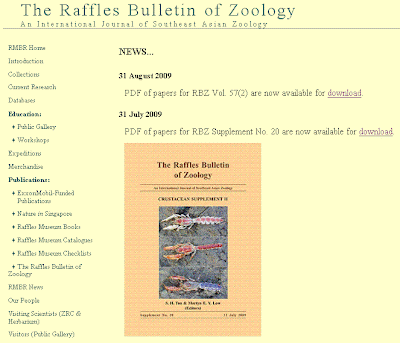 With lots of fascinating stuff to learn about our marine life from these papers!
With lots of fascinating stuff to learn about our marine life from these papers!I'm particularly excited about the paper on Oysters recorded from Malaysia and Singapore. This revision of our oysters resulted in 10 species of oysters recorded from Malaysia and Singapore, with three new records. The paper also includes an identification key based on shell characteristics! That's going to be helpful for us, although it's going to take me a while to figure out the Big Words.
 Read more on "Oysters (Bivalvia: Ostreidae and Gryphaeidae) recorded from Malaysia and Singapore". Katherine Lam and Brian Morton. Pp. 481–494. [pdf, 522 KB]
Read more on "Oysters (Bivalvia: Ostreidae and Gryphaeidae) recorded from Malaysia and Singapore". Katherine Lam and Brian Morton. Pp. 481–494. [pdf, 522 KB]There's also a paper on a new mud lobster species from Malaysia. It has details comparing this new species with Thalassina anomala and Thalassina gracilis, both of which are also found in Singapore. So the paper also helps us to learn more about the existing species as well.
 Read more on "A new species of Thalassina (Crustacea: Decapoda: Thalassinidae) from Malaysia". Moh H. H. and V. C. Chong. Pp. 465–473. [pdf, 341 KB]
Read more on "A new species of Thalassina (Crustacea: Decapoda: Thalassinidae) from Malaysia". Moh H. H. and V. C. Chong. Pp. 465–473. [pdf, 341 KB]And there's MORE about mud lobsters in the Crustacean Supplement II Supplement Series No. 20 (2009): i, 1–307: The genus Thalassina Latreille, 1806 (Crustacea: Thalassinidea: Thalassinidae). Nguyen Ngoc-Ho and Michèle de Saint Laurent. Pp. 121–158. [pdf, 2.23 MB]
Then there is this intriguing paper about a strange slug that was found in the solid mud bottom of the dense mangrove forest in Thailand. They are amphibious and live in and around small pools high in the intertidal zone, only submerged during spring high tides. The slugs are tiny (8-12mm) and feed on insect larvae and pupae. Amazing!
 These slugs are so strange, a new family Aitengidae has been erected for them. The name is derived from Ai Theng, one of the popular puppets in the shadow plays (wayang) in southern Thailand (depicted in A in the diagram above). It is a jolly, smooth, black male who plays in the night. The smooth Ai Theng with his large lateral eyes did remind the authors of the slug they just discovered.
These slugs are so strange, a new family Aitengidae has been erected for them. The name is derived from Ai Theng, one of the popular puppets in the shadow plays (wayang) in southern Thailand (depicted in A in the diagram above). It is a jolly, smooth, black male who plays in the night. The smooth Ai Theng with his large lateral eyes did remind the authors of the slug they just discovered.Read more on "Aiteng ater, new genus, new species, an amphibious and insectivorous sea slug that is difficult to classify [Mollusca: Gastropoda: Opisthobranchia: Sacoglossa(?): Aitengidae, new family]". Cornelis (Kees) Swennen and Somsak Buatip. Pp. 495–500. [pdf, 325 KB]
It's still possible to discover new large fishes! Another paper describes a new Angelfish species found in the tropical Western Pacific.
 Read more on "Chaetodontoplus poliourus, a new angelfish (Perciformes: Pomacanthidae) from the Tropical Western Pacific". John E. Randall and Luiz A. Rocha. Pp. 511–520. [pdf, 581 KB]
Read more on "Chaetodontoplus poliourus, a new angelfish (Perciformes: Pomacanthidae) from the Tropical Western Pacific". John E. Randall and Luiz A. Rocha. Pp. 511–520. [pdf, 581 KB]Other interesting papers on marine life include:
- Periclimenaeus nufu, a new species of shrimp (Crustacea: Decapoda: Pontoniinae) from Vietnam. Zdeněk Ďuriš, Ivona Horká and Dao Tan Hoc. Pp. 453–464. [pdf, 250 KB]
- A new species of Macrophthalmus Desmarest, 1823 (Crustacea: Decapoda: Brachyura: Macrophthalmidae) from Bohol Island, the Philippines. Jose Christopher E. Mendoza and Tohru Naruse. Pp. 475–480. [pdf, 120 KB]
- A new bandfish, Owstonia sarmiento (Pisces: Perciformes: Cepolidae: Owstoniinae), from the Philippines with a key to species of the genus. Yun-Chih Liao, Rodolfo B. Reyes Jr. and Kwang-Tsao Shao. Pp. 521–525. [pdf, 91 KB]
Go visit the Raffles Bulletin of Zoology website to download and view these and other papers.
The Raffles Bulletin of Zoology is a publication of the Raffles Museum of Biodiversity Research. The Bulletin was revived as a continuation of predecessing publications of the original Raffles Museum, originating in 1928. It is now a leading scientific journal that deals primarily with animal diversity in Southeast Asia, and one of the few publications in the region listed in the Science Citation Index and Current Contents.
This journal is peer-reviewed and published twice a year, with supplements (monographs) issued at irregular intervals (average twice a year). The editorial board boasts an international group of scientists with many distinguished experts in their respective fields of research.
